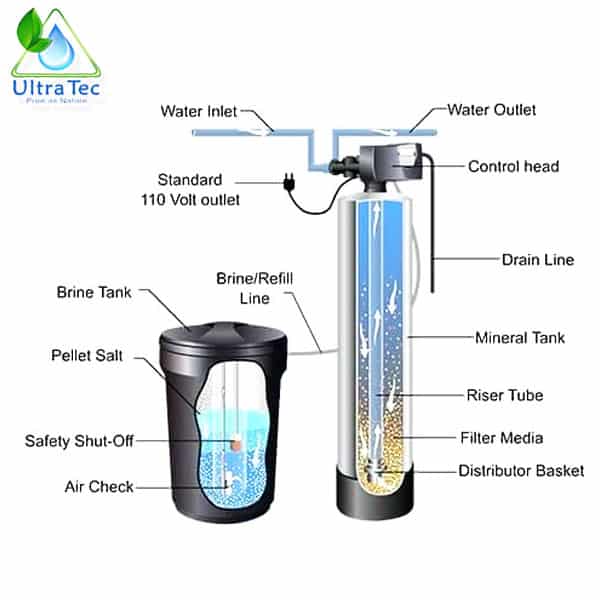How a Water Softener Can Transform Your Home’s Water Quality
Do you notice a white buildup on your faucets and showerheads, or do your dishes look spotty and streaky no matter how often you wash them? If so, you might be dealing with hard water. Hard water is a common issue that affects many households, but luckily, there’s an easy solution: a water softener.
A water softener is a device that removes minerals like calcium and magnesium from your water supply, preventing hard water buildup and improving water quality. This article will examine how a water softener can benefit your home and answer frequently asked questions about this helpful appliance.
How Water Softeners Work
Water softeners are appliances designed to remove hard water minerals from your water supply. They use an ion exchange process involving swapping calcium and magnesium ions for sodium ions.
The water softener consists of a tank filled with resin beads coated with sodium ions as hard water flows through the tank, the calcium and magnesium ions in the water stick to the resin beads, while the sodium ions are released into the water.
This process effectively “softens” the water, removing the minerals that cause hard water. Once the resin beads become coated with calcium and magnesium ions, they need to be cleaned in a process called regeneration.
A salt solution is added to the tank during regeneration, replacing the calcium and magnesium ions on the resin beads with sodium ions. The calcium and magnesium ions are flushed out of the tank and down the drain.
Benefits of Using a Water Softener
Using a water softener in your home can provide many benefits, including:
- Improving Water Quality: Hard water can leave your skin feeling dry and itchy, cause buildup on your fixtures, and leave your dishes looking dirty. By removing the minerals that cause hard water, a water softener can provide cleaner water for your skin, hair, and clothes.
- Saving Money: Hard water can cause damage to your appliances and plumbing over time, leading to costly repairs or replacements. Using a water softener, you can extend the lifespan of your appliances and plumbing and avoid expensive repairs.
- Reducing Soap and Detergent Usage: Hard water can make it challenging to create suds, meaning you need to use more soap and detergent to clean your clothes and dishes. With a water softener, you’ll use less soap and detergent, saving you money in the long run.
- Making cleaning Easier: Without hard water buildup, cleaning your fixtures, countertops, and other surfaces becomes more accessible and less time-consuming.
- Softer skin and hair: Hard water can be tough on your skin and hair, leaving them dry and brittle. Soft water is gentler, leaving your skin and hair soft and silky.
- Cleaner clothes and dishes: Hard water can cause buildup on your clothes and dishes, making them look dingy and dull. Soft water, on the other hand, can help keep your clothes and dishes looking clean and bright.
- Longer lifespan for appliances: Hard water can cause mineral buildup in your appliances, shortening their lifespan. Water softeners can help prevent this buildup, allowing your appliances to last longer.
Installation Process of water softener
Installing a water softener can be a complex process, and it’s generally recommended that you hire a professional to do it for you. However, if you’re handy with plumbing and have some experience with home improvement projects, you can tackle the job yourself.
Here are the basic steps involved in installing a water softener:
- Choose a location: You’ll need to choose a location for your water softener close to your water supply and has access to a drain.
- Shut off the water supply: Turn off the main water supply to your home to prevent water from flowing while installing the water softener.
- Install a bypass valve: You must install one to allow water to flow around the softener during regeneration.
- Install the water softener: Install the water softener in your chosen location, following the manufacturer’s instructions.
- Connect the water supply: Connect the water supply to the water softener according to the manufacturer’s instructions.
- Connect the drain: Connect the drain line to the water softener and run it to a nearby drain.
- Add salt to the water softener tank, following the manufacturer’s instructions.
- Test the water: Once the installation is complete, turn on the water supply and test the water to make sure it’s soft.
If you need more time to install a water softener yourself, it’s best to hire a professional to do it for you. They’ll be able to ensure that the installation is done correctly, and they’ll be able to answer any questions you may have.
FAQs
Q: Do water softeners require maintenance?
A: Yes, water softeners do require some maintenance. You’ll need to add salt to the tank regularly, and you’ll also need to clean the resin beads periodically.
Q: Will a water softener remove all minerals from my water?
A: No, a water softener will only remove the minerals that cause hard water, like calcium and magnesium. It won’t remove other minerals or impurities from your water.
Q: How long will a water softener last?
A: A well-maintained water softener lasts 10-15 years or more.
Q: Can I drink softened water?
A: Yes, you can drink softened water. However, some people prefer a separate tap for drinking water that bypasses the water softener.




